Cantore arithmetic is the avenue to a charted method of subtraction and addition to divide at the what is the equal and or equals the weather mathematics is missing the piece that adds to what is that slice of heaven at Pi to square with Albert Einstein. To engage this imagine at what is real to what is happening invokes the current at strength and question: The apex to the sinkhole. As this represents the movement of water to the reality of ground does the motion place to how a coin is named?
A head and tale opens the coin to what is the thirty pieces of silver at how square map place the Aztec to the Mayan and temple the pyramid to a vortex that explains the cap in explanation for the Egyptian story to place importance to stone at every grain.
The collection of ice would melt and the freeze or the balance at a given would create mud, to encourage the extraction and place salt to sediment. A simple speech to anchor the Grand Canyon at a picture perfect valley of the North to balance the needle, a compass for the heat to depth and quartz.
To place Nostradamus in this note as a parameter may or may not acquaintance the shake as salt is not the grain of this substance however the written letter to such may find the ground in the sequence from Fibonacci returning Leonardo Da Vinci to balance at a new graph to charge the appearance on computer the importance of the work of Srinivasa Ramanujan. To understand the work of general appearance invokes the candor of the Viking at the horse as this movement shows the work of wealth in a speaking easy to the excitement of new mathematics.
To see evolution invites ‘The Missing Piece’ to a new path that totals earth at a known environment for all parties(Missing Link) at the present rather leaving the animal mammal and human in placed. This does not interfere with need for explanation of man and opens an idea without the criticism placing a new method to look at the moon in development and to obtain earth without the deep impact of such destruction in order for the leavings of the dinosaur to be studied and not just used or extracted, i.e. tar. A volcanic approach levels the idea of liquid measure and places to what is the liter to quarts as river to metal?
This approach returns to the computer and is able to appreciate Alan Turing to state of being the man that built the computer after the human brain. To accurate timeline for the “Missing Link” will establish.
Waterspout
| Part of a series on |
| Weather |
|---|
 |
A waterspout is an intense columnar vortex (usually appearing as a funnel-shaped cloud) that occurs over a body of water.[1] Some are connected to a cumulus congestus cloud, some to a cumuliform cloud and some to a cumulonimbus cloud.[2] In the common form, a waterspout is a non-supercell tornado over water having a five-part life cycle: formation of a dark spot on the water surface; spiral pattern on the water surface; formation of a spray ring; development of a visible condensation funnel; and ultimately, decay.[2][3][4]
Most waterspouts do not suck up water; they are small, weak rotating columns of air over water.[2][5] Although typically weaker than their land counterparts, stronger versions—spawned by mesocyclones—do occasionally occur.[6][7]
While waterspouts form mostly in tropical and subtropical areas,[2] they are also reported in Europe, Western Asia (the Middle East),[8] Australia, New Zealand, the Great Lakes, Antarctica,[9][10] and on rare occasions, the Great Salt Lake.[11] Some are also found on the East Coast of the United States, and the coast of California.[1]Although rare, waterspouts have been observed in connection with lake-effect snow precipitation bands.
Characteristics[edit]
Climatology[edit]
Though the majority of waterspouts occur in the tropics, they can seasonally appear in temperate areas throughout the world, and are common across the western coast of Europe as well as the British Isles and several areas of the Mediterranean and Baltic Sea. They are not restricted to saltwater; many have been reported on lakes and rivers including the Great Lakes and the St. Lawrence River.[12] They are fairly common on the Great Lakes during late summer and early fall, with a record 66+ waterspouts reported over just a seven-day period in 2003.[13]
Waterspouts are more frequent within 100 km (60 mi) from the coast than farther out at sea. They are common along the southeast U.S. coast, especially off southern Florida and the Keys, and can happen over seas, bays, and lakes worldwide. Approximately 160 waterspouts are currently reported per year across Europe, with the Netherlands reporting the most at 60, followed by Spain and Italy at 25, and the United Kingdom at 15. They are most common in late summer. In the Northern Hemisphere, September has been pinpointed as the prime month of formation.[13] Waterspouts are also frequently observed off the east coast of Australia, with several being described by Joseph Banks during the voyage of the Endeavour in 1770.[14][15][16]
Formation[edit]
Waterspouts exist on a microscale, where their environment is less than two kilometers in width. The cloud from which they develop can be as innocuous as a moderate cumulus, or as great as a supercell. While some waterspouts are strong and tornadic in nature, most are much weaker and caused by different atmospheric dynamics. They normally develop in moisture-laden environments as their parent clouds are in the process of development, and it is theorized they spin as they move up the surface boundary from the horizontal shear near the surface, and then stretch upwards to the cloud once the low-level shear vortex aligns with a developing cumulus cloud or thunderstorm. Some weak tornadoes, known as landspouts, have been shown to develop in a similar manner.[17]
More than one waterspout can occur simultaneously in the same vicinity. In 2012, as many as nine simultaneous waterspouts were reported on Lake Michigan in the United States.[9] In May 2021, at least five simultaneous waterspouts were filmed near Taree, off the northern coast of New South Wales, Australia.[14]
Types[edit]
Non-tornadic[edit]
Waterspouts that are not associated with a rotating updraft of a supercell thunderstorm are known as "non-tornadic" or "fair-weather" waterspouts. By far the most common type of waterspout, these occur in coastal waters and are associated with dark, flat-bottomed, developing convective cumulus towers. Fair-weather waterspouts develop and dissipate rapidly, having life cycles shorter than 20 minutes.[17] They usually rate no higher than EF0 on the Enhanced Fujita scale, generally exhibiting winds of less than 30 m/s (67 mph; 108 km/h).[18]
They are most frequently seen in tropical and sub-tropical climates, with upwards of 400 per year observed in the Florida Keys.[19] They typically move slowly, if at all, since the cloud to which they are attached is horizontally static, being formed by vertical convective action rather than the subduction/adduction interaction between colliding fronts.[19][20] Fair-weather waterspouts are very similar in both appearance and mechanics to landspouts, and largely behave as such if they move ashore.[19]
There are five stages to a fair-weather waterspout life cycle. Initially, a prominent circular, light-colored disk appears on the surface of the water, surrounded by a larger dark area of indeterminate shape. After the formation of these colored disks on the water, a pattern of light- and dark-colored spiral bands develops from the dark spot on the water surface. Then, a dense annulus of sea spray, called a "cascade", appears around the dark spot with what appears to be an eye. Eventually, the waterspout becomes a visible funnel from the water surface to the overhead cloud. The spray vortex can rise to a height of several hundred feet or more, and often creates a visible wake and an associated wave train as it moves. Finally, the funnel and spray vortex begin to dissipate as the inflow of warm air into the vortex weakens, ending the waterspout's life cycle.[20]
Tornadic[edit]
"Tornadic waterspouts", also accurately referred to as "tornadoes over water", are formed from mesocyclones in a manner essentially identical to land-based tornadoes in connection with severe thunderstorms, but simply occurring over water.[21] A tornado which travels from land to a body of water would also be considered a tornadic waterspout.[22] Since the vast majority of mesocyclonic thunderstorms in the United States occur in land-locked areas, true tornadic waterspouts are correspondingly rarer than their fair-weather counterparts in that country. However, in some areas, such as the Adriatic, Aegean and Ionian seas,[23] tornadic waterspouts can make up half of the total number.[24]
Snowspout[edit]
A winter waterspout, also known as an icespout, an ice devil, or a snowspout, is a rare instance of a waterspout forming under the base of a snow squall.[25] The term "winter waterspout" is used to differentiate between the common warm season waterspout and this rare winter season event. There are a couple of critical criteria for the formation of a winter waterspout. Very cold temperatures need to be present over a body of water, which is itself warm enough to produce fog resembling steam above the water's surface. Like the more efficient lake-effect snow events, winds focusing down the axis of long lakes enhance wind convergence and increase the likelihood of a winter waterspout developing.[26]
The terms "snow devil" and "snownado" describe a different phenomenon: a snow vortex close to the surface with no parent cloud, similar to a dust devil.[27]
Impacts[edit]
Human[edit]
Waterspouts have long been recognized as serious marine hazards. Stronger waterspouts pose a threat to watercraft, aircraft and people.[28] It is recommended to keep a considerable distance from these phenomena, and to always be on alert through weather reports. The United States National Weather Service will often issue special marine warnings when waterspouts are likely or have been sighted over coastal waters, or tornado warnings when waterspouts are expected to move onshore.[29]
Incidents of waterspouts causing severe damage and casualties are rare; however, there have been several notable examples. The Malta tornado of 1551 was the earliest recorded occurrence of a deadly waterspout. It struck the Grand Harbour of Valletta, sinking four galleys and numerous boats, and claiming hundreds of lives.[30]The 1851 Sicily tornadoes were twin waterspouts that made landfall in western Sicily, ravaging the coast and countryside before ultimately dissipating back again over the sea.
Natural[edit]
Depending on how fast the winds from a waterspout are whipping, anything that is within about 90 cm (1 yard) of the surface of the water, including fish of different sizes, frogs, and even turtles, can be lifted into the air.[31] A waterspout can sometimes suck small animals such as fish out of the water and all the way up into the cloud. Even if the waterspout stops spinning, the fish in the cloud can be carried over land, buffeted up and down and around with the cloud's winds until its currents no longer keep the flying fish in the atmosphere. Depending on how far they travel and how high they are taken into the atmosphere, the fish are sometimes dead by the time they rain down. People as far as 160 km (100 miles) inland have experienced raining fish.[31] Fish can also be sucked up from rivers, but raining fish is not a common weather phenomenon.[31]
Research and forecasting[edit]
The Szilagyi Waterspout Index (SWI), developed by Canadian meteorologist Wade Szilagyi, is used to predict conditions favorable for waterspout development. The SWI ranges from −10 to +10, where values greater than or equal to zero represent conditions favorable for waterspout development.[32][33]
The International Centre for Waterspout Research (ICWR) is a non-governmental organization of individuals from around the world who are interested in the field of waterspouts from a research, operational and safety perspective.[34] Originally a forum for researchers and meteorologists, the ICWR has expanded interest and contribution from storm chasers, the media, the marine and aviation communities and from private individuals.
Myths[edit]
There was a commonly held belief among sailors in the 18th and 19th centuries that shooting a broadside cannon volley dispersed waterspouts.[35][36][37] Among others, Captain Vladimir Bronevskiy claims that it was a successful technique, having been an eyewitness to the dissipation of a phenomenon in the Adriatic while a midshipman aboard the frigate Venus during the 1806 campaign under Admiral Senyavin.[38]
A waterspout has been proposed as a reason for the abandonment of the Mary Celeste.[39]
Sleipnir
In Norse mythology, Sleipnir /ˈsleɪpnɪər/ (Old Norse: [ˈslɛipnez̠]; "slippy"[1] or "the slipper"[2]) is an eight-legged horse ridden by Odin. Sleipnir is attested in the Poetic Edda, compiled in the 13th century from earlier traditional sources, and the Prose Edda, written in the 13th century by Snorri Sturluson. In both sources, Sleipnir is Odin's steed, is the child of Loki and Svaðilfari, is described as the best of all horses, and is sometimes ridden to the location of Hel. The Prose Edda contains extended information regarding the circumstances of Sleipnir's birth, and details that he is grey in color.
Sleipnir is also mentioned in a riddle found in the 13th century legendary saga Hervarar saga ok Heiðreks, in the 13th-century legendary saga Völsunga saga as the ancestor of the horse Grani, and book I of Gesta Danorum, written in the 12th century by Saxo Grammaticus, contains an episode considered by many scholars to involve Sleipnir. Sleipnir is generally accepted as depicted on two 8th century Gotlandic image stones: the Tjängvide image stone and the Ardre VIII image stone.
Scholarly theories have been proposed regarding Sleipnir's potential connection to shamanicpractices among the Norse pagans. In modern times, Sleipnir appears in Icelandic folklore as the creator of Ásbyrgi, in works of art, literature, software, and in the names of ships.
Attestations[edit]
Poetic Edda[edit]
In the Poetic Edda, Sleipnir appears or is mentioned in the poems Grímnismál, Sigrdrífumál, Baldrs draumar, and Hyndluljóð. In Grímnismál, Grimnir (Odin in disguise and not yet having revealed his identity) tells the boy Agnar in verse that Sleipnir is the best of horses ("Odin is the best of the Æsir, Sleipnir of horses").[3] In Sigrdrífumál, the valkyrie Sigrdrífa tells the hero Sigurðr that runes should be cut "on Sleipnir's teeth and on the sledge's strap-bands."[4] In Baldrs draumar, after the Æsir convene about the god Baldr's bad dreams, Odin places a saddle on Sleipnir and the two proceed to the location of Hel.[5] The Völuspá hin skamma section of Hyndluljóð says that Loki produced "the wolf" with Angrboða, produced Sleipnir with Svaðilfari, and thirdly "one monster that was thought the most baleful, who was descended from Býleistr's brother."[6]
Prose Edda[edit]
In the Prose Edda book Gylfaginning, Sleipnir is first mentioned in chapter 15 where the enthroned figure of Highsays that every day the Æsir ride across the bridge Bifröst, and provides a list of the Æsir's horses. The list begins with Sleipnir: "best is Sleipnir, he is Odin's, he has eight legs."[7] In chapter 41, High quotes the Grímnismál stanza that mentions Sleipnir.[8]
In chapter 42, Sleipnir's origins are described. Gangleri (described earlier in the book as King Gylfi in disguise) asks High who the horse Sleipnir belongs to and what there is to tell about it. High expresses surprise at Gangleri's lack of knowledge about Sleipnir and its origin. High tells a story set "right at the beginning of the gods' settlement when the gods established Midgard and built Val-Hall" about an unnamed builder who has offered to build a fortification for the gods in three seasons that will keep out invaders in exchange for the goddess Freyja, the sun, and the moon. After some debate, the gods agree to this, but place a number of restrictions on the builder, including that he must complete the work within three seasons with the help of no man. The builder makes a single request; that he may have help from his stallion Svaðilfari, and due to Loki's influence, this is allowed. The stallion Svaðilfari performs twice the deeds of strength as the builder and hauls enormous rocks to the surprise of the gods. The builder, with Svaðilfari, makes fast progress on the wall, and three days before the deadline of summer, the builder was nearly at the entrance to the fortification. The gods convene and figured out who was responsible, resulting in a unanimous agreement that, along with most trouble, Loki was to blame.[9]
The gods declare that Loki would deserve a horrible death if he could not find a scheme that would cause the builder to forfeit his payment, and threatened to attack him. Loki, afraid, swore oaths that he would devise a scheme to cause the builder to forfeit the payment, whatever it would cost himself. That night, the builder drove out to fetch stone with his stallion Svaðilfari, and out from a wood ran a mare. The mare neighed at Svaðilfari, and "realizing what kind of horse it was," Svaðilfari became frantic, neighed, tore apart his tackle, and ran towards the mare. The mare ran to the wood, Svaðilfari followed, and the builder chased after. The two horses ran around all night, causing the building work to be held up for the night, and the previous momentum of building work that the builder had been able to maintain was not continued.[10]
When the Æsir realize that the builder is a hrimthurs, they disregard their previous oaths with the builder, and call for Thor. Thor arrives, and kills the builder by smashing the builder's skull into shards with the hammer Mjöllnir. However, Loki had "such dealings" with Svaðilfari that "somewhat later" Loki gave birth to a grey foal with eight legs; the horse Sleipnir, "the best horse among gods and men."[10]
In chapter 49, High describes the death of the god Baldr. Hermóðr agrees to ride to Hel to offer a ransom for Baldr's return, and so "then Odin's horse Sleipnir was fetched and led forward." Hermóðr mounts Sleipnir and rides away. Hermóðr rides for nine nights in deep, dark valleys where Hermóðr can see nothing. The two arrive at the river Gjöll and then continue to Gjöll bridge, encountering a maiden guarding the bridge named Móðguðr. Some dialogue occurs between Hermóðr and Móðguðr, including that Móðguðr notes that recently there had ridden five battalions of dead men across the bridge that made less sound than he. Sleipnir and Hermóðr continue "downwards and northwards" on the road to Hel, until the two arrive at Hel's gates. Hermóðr dismounts from Sleipnir, tightens Sleipnir's girth, mounts him, and spurs Sleipnir on. Sleipnir "jumped so hard and over the gate that it came nowhere near." Hermóðr rides up to the hall, and dismounts from Sleipnir. After Hermóðr's pleas to Helto return Baldr are accepted under a condition, Hermóðr and Baldr retrace their path backward and return to Asgard.[11]
In chapter 16 of the book Skáldskaparmál, a kenning given for Loki is "relative of Sleipnir."[12] In chapter 17, a story is provided in which Odin rides Sleipnir into the land of Jötunheimr and arrives at the residence of the jötunn Hrungnir. Hrungnir asks "what sort of person this was" wearing a golden helmet, "riding sky and sea," and says that the stranger "has a marvellously good horse." Odin wagers his head that no horse as good could be found in all of Jötunheimr. Hrungnir admitted that it was a fine horse, yet states that he owns a much longer-paced horse; Gullfaxi. Incensed, Hrungnir leaps atop Gullfaxi, intending to attack Odin for Odin's boasting. Odin gallops hard ahead of Hrungnir, and, in his, fury, Hrungnir finds himself having rushed into the gates of Asgard.[13] In chapter 58, Sleipnir is mentioned among a list of horses in Þorgrímsþula: "Hrafn and Sleipnir, splendid horses [...]".[14] In addition, Sleipnir occurs twice in kennings for "ship" (once appearing in chapter 25 in a work by the skald Refr, and "sea-Sleipnir" appearing in chapter 49 in Húsdrápa, a work by the 10th century skald Úlfr Uggason).[15]
Hervarar saga ok Heiðreks[edit]
In Hervarar saga ok Heiðreks, the poem Heiðreks gátur contains a riddle that mentions Sleipnir and Odin:
Völsunga saga[edit]
In chapter 13 of Völsunga saga, the hero Sigurðr is on his way to a wood and he meets a long-bearded old man he had never seen before. Sigurd tells the old man that he is going to choose a horse, and asks the old man to come with him to help him decide. The old man says that they should drive the horses down to the river Busiltjörn. The two drive the horses down into the deeps of Busiltjörn, and all of the horses swim back to land but a large, young, and handsome grey horse that no one had ever mounted. The grey-bearded old man says that the horse is from "Sleipnir's kin" and that "he must be raised carefully, because he will become better than any other horse." The old man vanishes. Sigurd names the horse Grani, and the narrative adds that the old man was none other than (the god) Odin.[17]
Gesta Danorum[edit]
Sleipnir is generally considered as appearing in a sequence of events described in book I of Gesta Danorum.[18]
In book I, the young Hadingus encounters "a certain man of great age who had lost an eye" who allies him with Liserus. Hadingus and Liserus set out to wage war on Lokerus, ruler of Kurland. Meeting defeat, the old man takes Hadingus with him onto his horse as they flee to the old man's house, and the two drink an invigorating draught. The old man sings a prophecy, and takes Hadingus back to where he found him on his horse. During the ride back, Hadingus trembles beneath the old man's mantle, and peers out of its holes. Hadingus realizes that Sleipnir is running over the sea: "and he saw that before the steps of the horse lay the sea; but was told not to steal a glimpse of the forbidden thing, and therefore turned his amazed eyes from the dread spectacle of the roads that he journeyed."[19]
In book II, Biarco mentions Odin and Sleipnir: "If I may look on the awful husband of Frigg, howsoever he be covered in his white shield, and guide his tall steed, he shall in no way go safe out of Leire; it is lawful to lay low in war the war-waging god."[20]
Archaeological record[edit]
Two of the 8th century picture stones from the island of Gotland, Sweden depict eight-legged horses, which are thought by most scholars to depict Sleipnir: the Tjängvide image stone and the Ardre VIII image stone. Both stones feature a rider sitting atop an eight-legged horse, which some scholars view as Odin. Above the rider on the Tjängvide image stone is a horizontal figure holding a spear, which may be a valkyrie, and a female figure greets the rider with a cup. The scene has been interpreted as a rider arriving at the world of the dead.[21] The mid-7th century Eggja stone bearing the Odinic name haras (Old Norse 'army god') may be interpreted as depicting Sleipnir.[22]
Theories[edit]
John Lindow theorizes that Sleipnir's "connection to the world of the dead grants a special poignancy to one of the kennings in which Sleipnir turns up as a horse word," referring to the skald Úlfr Uggason's usage of "sea-Sleipnir" in his Húsdrápa, which describes the funeral of Baldr. Lindow continues that "his use of Sleipnir in the kenning may show that Sleipnir's role in the failed recovery of Baldr was known at that time and place in Iceland; it certainly indicates that Sleipnir was an active participant in the mythology of the last decades of paganism." Lindow adds that the eight legs of Sleipnir "have been interpreted as an indication of great speed or as being connected in some unclear way with cult activity."[21]
Hilda Ellis Davidson says that "the eight-legged horse of Odin is the typical steed of the shaman" and that in the shaman's journeys to the heavens or the underworld, a shaman "is usually represented as riding on some bird or animal." Davidson says that while the creature may vary, the horse is fairly common "in the lands where horses are in general use, and Sleipnir's ability to bear the god through the air is typical of the shaman's steed" and cites an example from a study of shamanism by Mircea Eliade of an eight-legged foal from a story of a Buryatshaman. Davidson says that while attempts have been made to connect Sleipnir with hobby horses and steeds with more than four feet that appear in carnivals and processions, but that "a more fruitful resemblance seems to be on the bier on which a dead man is carried in the funeral procession by four bearers; borne along thus, he may be described as riding on a steed with eight legs." As an example, Davidson cites a funeral dirge from the Gondi peoplein India as recorded by Verrier Elwin, stating that "it contains references to Bagri Maro, the horse with eight legs, and it is clear from the song that it is the dead man's bier." Davidson says that the song is sung when a distinguished Muria dies, and provides a verse:[23]
Davidson adds that the representation of Odin's steed as eight-legged could arise naturally out of such an image, and that "this is in accordance with the picture of Sleipnir as a horse that could bear its rider to the land of the dead."[23]
Ulla Loumand cites Sleipnir and the flying horse Hófvarpnir as "prime examples" of horses in Norse mythology as being able to "mediate between earth and sky, between Ásgarðr, Miðgarðr and Útgarðr and between the world of mortal men and the underworld."[24]
The Encyclopedia of Indo-European Culture theorizes that Sleipnir's eight legs may be the remnants of horse-associated divine twins found in Indo-European cultures and ultimately stemming from Proto-Indo-European religion. The encyclopedia states that "[...] Sleipnir is born with an extra set of legs, thus representing an original pair of horses. Like Freyr and Njörðr, Sleipnir is responsible for carrying the dead to the otherworld." The encyclopedia cites parallels between the birth of Sleipnir and myths originally pointing to a Celtic goddess who gave birth to the Divine horse twins. These elements include a demand for a goddess by an unwanted suitor (the hrimthurs demanding the goddess Freyja) and the seduction of builders.[25]
Modern influence[edit]
According to Icelandic folklore, the horseshoe-shaped canyon Ásbyrgi located in Jökulsárgljúfur National Park, northern Iceland was formed by Sleipnir's hoof.[26] Sleipnir is depicted with Odin on Dagfin Werenskiold's wooden relief Odin på Sleipnir (1945–1950) on the exterior of the Oslo City Hall in Oslo, Norway.[27] Sleipnir has been and remains a popular name for ships in northern Europe, and Rudyard Kipling's short story entitled Sleipnir, late Thurinda (1888) features a horse named Sleipnir.[28][26] A statue of Sleipnir (1998) stands in Wednesbury, England, a town which takes its name from the Anglo-Saxon version of Odin, Wōden.[29]
Seahorse
| Seahorses Temporal range: Lower Miocene to present – | |
|---|---|
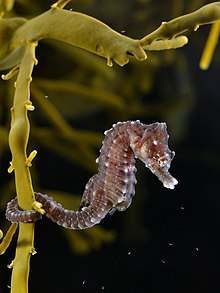 | |
| Short-snouted seahorse (Hippocampus hippocampus) | |
| Scientific classification | |
| Kingdom: | Animalia |
| Phylum: | Chordata |
| Class: | Actinopterygii |
| Order: | Syngnathiformes |
| Family: | Syngnathidae |
| Subfamily: | Hippocampinae |
| Genus: | Hippocampus Rafinesque, 1810[1][2] |
| Type species | |
| Hippocampus heptagonus Rafinesque, 1810 | |
| Species | |
see Species. | |
| Synonyms | |
A seahorse (also written sea-horse and sea horse) is any of 46 species of small marine fish in the genusHippocampus. "Hippocampus" comes from the Ancient Greek hippókampos (ἱππόκαμπος), itself from híppos(ἵππος) meaning "horse" and kámpos (κάμπος) meaning "sea monster"[4][5] or "sea animal".[6] Having a head and neck suggestive of a horse, seahorses also feature segmented bony armour, an upright posture and a curled prehensile tail.[7] Along with the pipefishes and seadragons (Phycodurus and Phyllopteryx) they form the family Syngnathidae.
Habitat[edit]
Seahorses are mainly found in shallow tropical and temperate salt water throughout the world, from about 45°S to 45°N.[8] They live in sheltered areas such as seagrass beds, estuaries, coral reefs, and mangroves. Four species are found in Pacific waters from North America to South America. In the Atlantic, Hippocampus erectus ranges from Nova Scotia to Uruguay. H. zosterae, known as the dwarf seahorse, is found in the Bahamas.
Colonies have been found in European waters such as the Thames Estuary.[9]
Three species live in the Mediterranean Sea: H. guttulatus (the long-snouted seahorse), H. hippocampus (the short-snouted seahorse), and H. fuscus (the sea pony). These species form territories; males stay within 1 m2(10 sq ft) of habitat, while females range over about one hundred times that.
Description[edit]
Seahorses range in size from 1.5 to 35.5 cm (5⁄8 to 14 in).[10] They are named for their equine appearance, with bent necks and long snouted heads and a distinctive trunk and tail. Although they are bony fish, they do not have scales, but rather thin skin stretched over a series of bony plates, which are arranged in rings throughout their bodies. Each species has a distinct number of rings.[11] The armor of bony plates also protects them against predators,[12] and because of this outer skeleton, they no longer have ribs.[13] Seahorses swim upright, propelling themselves using the dorsal fin, another characteristic not shared by their close pipefish relatives, which swim horizontally. Razorfish are the only other fish that swim vertically. The pectoral fins, located on either side of the head behind their eyes, are used for steering. They lack the caudal fin typical of fishes. Their prehensile tail is composed of square-like rings that can be unlocked only in the most extreme conditions.[14] They are adept at camouflage, and can grow and reabsorb spiny appendages depending on their habitat.[15]
Unusually among fish, a seahorse has a flexible, well-defined neck. It also sports a crown-like spine or horn on its head, termed a "coronet", which is distinct for each species.[16]
Seahorses swim very poorly, rapidly fluttering a dorsal fin and using pectoral fins to steer. The slowest-moving fish in the world is H. zosterae (the dwarf seahorse), with a top speed of about 1.5 m (5 ft) per hour.[17] Since they are poor swimmers, they are most likely to be found resting with their prehensile tail wound around a stationary object. They have long snouts, which they use to suck up food, and their eyes can move independently of each other like those of a chameleon.[18]
Evolution and fossil record[edit]
Anatomical evidence, supported by molecular, physical, and genetic evidence, demonstrates that seahorses are highly modified pipefish. The fossil record of seahorses, however, is very sparse. The best known and best studied fossils are specimens of Hippocampus guttulatus (though literature more commonly refers to them under the synonym of H. ramulosus), from the Marecchia River formation of Rimini Province, Italy, dating back to the Lower Pliocene, about 3 million years ago. The earliest known seahorse fossils are of two pipefish-like species, H. sarmaticus and H. slovenicus, from the coprolitic horizon of Tunjice Hills, a middle Miocene lagerstätte in Slovenia dating back about 13 million years.[19]
Molecular dating implies that pipefish and seahorses diverged during the Late Oligocene. This has led to speculation that seahorses evolved in response to large areas of shallow water, newly created as the result of tectonic events. The shallow water would have allowed the expansion of seagrass habitats that served as camouflage for the seahorses' upright posture.[20] These tectonic changes occurred in the western Pacific Ocean, pointing to an origin there, with molecular data suggesting two later, separate invasions of the Atlantic Ocean.[21] In 2016, a study published in Naturefound the seahorse genome to be the most rapidly evolving fish genome studied so far.[22]
The evolution of seahorses from pipefish may have been an adaptation related to the biomechanics of prey capture. The unique posture of the seahorse allows them to capture small shrimps at larger distances than the pipefish is capable of.[23]
Reproduction[edit]
The male seahorse is equipped with a brood pouch on the ventral, or front-facing, side of the tail. When mating, the female seahorse deposits up to 1,500 eggs in the male's pouch. The male carries the eggs for 9 to 45 days until the seahorses emerge fully developed, but very small. The young are then released into the water, and the male often mates again within hours or days during the breeding season.[24]
Courtship[edit]
Before breeding, seahorses may court for several days. Scientists believe the courtship behavior synchronizes the animals' movements and reproductive states, so that the male can receive the eggs when the female is ready to deposit them. During this time, they may change color, swim side by side holding tails or grip the same strand of sea grass with their tails, and wheel around in unison in what is known as a "predawn dance". They eventually engage in a "true courtship dance" lasting about 8 hours, during which the male pumps water through the egg pouch on his trunk which expands and opens to display its emptiness. When the female's eggs reach maturity, she and her mate let go of any anchors and drift upward snout-to-snout, out of the sea grass, often spiraling as they rise. They interact for about 6 minutes, reminiscent of courtship. The female then swims away until the next morning, and the male returns to sucking up food through his snout.[25] The female inserts her ovipositor into the male's brood pouch and deposits dozens to thousands of eggs. As the female releases her eggs, her body slims while his swells. Both animals then sink back into the sea grass and she swims away.[26]
Phases of courtship[edit]
Seahorses exhibit four phases of courtship that are indicated by clear behavioral changes and changes in the intensity of the courtship act. Phase 1, the initial courtship phase, typically takes place in the early morning one or two days before physical copulation. During this phase the potential mates brighten in colour, quiver, and display rapid side-to-side body vibrations. These displays are performed alternately by both the male and the female seahorse. The following phases, 2 through 4, happen sequentially on the day of copulation. Phase 2 is marked by the female pointing, a behaviour in which the female will raise her head to form an oblique angle with her body. In phase 3 males will also begin the same pointing behaviour in response to the female. Finally, the male and female will repeatedly rise upward together in a water column and end in mid-water copulation, in which the female will transfer her eggs directly into the male's brood pouch.[27]
Phase 1: Initial courtship[edit]
This initial courtship behaviour takes place about 30 minutes after dawn on each courtship day, until the day of copulation. During this phase the males and females will remain apart during the night, but after dawn they will come together in a side-by-side position, brighten, and engage in courtship behaviour for about 2 to 38 minutes. There is repeated reciprocal quivering. This starts when the male approaches the female, brightens and begins to quiver. The female will follow the male with her own display, in which she will also brighten and quiver about 5 seconds later. As the male quivers, he will rotate his body towards the female who will then rotate her body away. During phase 1 the tails of both seahorses are positioned within 1 cm of each other on the same hold-fast and both of their bodies are angled slightly outward from the point of attachment. However, the female will shift her tail attachment site, causing the pair to circle their common hold-fast.[27]
Phase 2: Pointing and pumping[edit]
This phase begins with the female beginning her pointing posture, by leaning her body towards the male, who will simultaneously lean away and quiver. This phase can last up to 54 minutes. Following phase 2 is a latency period (typically between 30 minutes and four hours), during which the seahorses display no courtship behaviour and females are not bright; males will usually display a pumping motion with their body.[27]
Phase 3: Pointing – pointing[edit]
The third phase begins with the females brightening and assuming the pointing position. The males respond with their own brightening and pointing display. This phase ends with the male departing. It usually lasts nine minutes and can occur one to six times during courtship.[27]
Phase 4: Rising and copulation[edit]
The final courtship phase includes 5-8 bouts of courtship. Each bout of courtship begins with both the male and female anchored to the same plant about 3 cm apart; usually they are facing each other and are still bright in colour from the previous phase. During the first bout, following the facing behaviour, the seahorses will rise upward together anywhere from 2 to 13 cm in a water column. During the final rise the female will insert her ovipositor and transfer her eggs though an opening into the male's brood pouch.[27]
Fertilization[edit]
During fertilization in Hippocampus kuda the brood pouch was found to be open for only six seconds while egg deposition occurred. During this time seawater entered the pouch where the spermatozoa and eggs meet in a seawater milieu. This hyperosmotic environment facilitates sperm activation and motility. The fertilization is therefore regarded as being physiologically ‘external’ within a physically ‘internal’ environment after the closure of the pouch.[28]It is believed that this protected form of fertilization reduces sperm competition among males. Within the Syngnathidae (pipefishes and seahorses) protected fertilization has not been documented in the pipefishes but the lack of any distinct differences in the relation of testes size to body size suggests that pipefishes may also have evolved mechanisms for more efficient fertilization with reduced sperm competition.[29]
Gestation[edit]
The fertilized eggs are then embedded in the pouch wall and become surrounded by a spongy tissue.[30] The male supplies the eggs with prolactin, the same hormone responsible for milk production in pregnant mammals.[citation needed] The pouch provides oxygen,[31] as well as a controlled environment incubator. Though the egg yolk contributes nourishment to the developing embryo, the male sea horses contribute additional nutrients such as energy-rich lipids and also calcium to allow them to build their skeletal system, by secreting them into the brood pouch that are absorbed by the embryos. Further they also offer immunological protection, osmoregulation, gas exchange and waste transport.[32]
The eggs then hatch in the pouch, where the salinity of the water is regulated; this prepares the newborns for life in the sea.[25][33][34] Throughout gestation, which in most species requires two to four weeks, his mate visits him daily for “morning greetings”.
Birth[edit]
The number of young released by the male seahorse averages 100–1000 for most species, but may be as low as 5 for the smaller species, or as high as 2,500.[30] When the fry are ready to be born, the male expels them with muscular contractions. He typically gives birth at night and is ready for the next batch of eggs by morning when his mate returns. Like almost all other fish species, seahorses do not nurture their young after birth. Infants are susceptible to predators or ocean currents which wash them away from feeding grounds or into temperatures too extreme for their delicate bodies. Less than 0.5% of infants survive to adulthood, explaining why litters are so large. These survival rates are actually fairly high compared to other fish, because of their protected gestation, making the process worth the great cost to the father. The eggs of most other fish are abandoned immediately after fertilization.[34]
Reproductive roles[edit]
Reproduction is energetically costly to the male. This brings into question why the sexual role reversal even takes place. In an environment where one partner incurs more energy costs than the other, Bateman's principlesuggests that the lesser contributor takes the role of the aggressor. Male seahorses are more aggressive and sometimes “fight” for female attention. According to Amanda Vincent of Project Seahorse, only males tail-wrestle and snap their heads at each other. This discovery prompted further study of energy costs. To estimate the female's direct contribution, researchers chemically analyzed the energy stored in each egg. To measure the burden on the males, oxygen consumption was used. By the end of incubation, the male consumed almost 33% more oxygen than before mating. The study concluded that the female's energy expenditure while generating eggs is twice that of males during incubation, confirming the standard hypothesis.[25]
Why the male seahorse (and other members of the Syngnathidae) carries the offspring through gestation is unknown, though some researchers believe it allows for shorter birthing intervals, in turn resulting in more offspring.[35] Given an unlimited number of ready and willing partners, males have the potential to produce 17% more offspring than females in a breeding season. Also, females have “time-outs” from the reproductive cycle 1.2 times longer than those of males. This seems to be based on mate choice, rather than physiology. When the female's eggs are ready, she must lay them in a few hours or eject them into the water column. Making eggs is a huge cost to her physically, since they amount to about a third of her body weight. To protect against losing a clutch, the female demands a long courtship. The daily greetings help to cement the bond between the pair.[36]
Monogamy[edit]
Though seahorses are not known to mate for life, many species form pair bonds that last through at least the breeding season. Some species show a higher level of mate fidelity than others.[37][38] However, many species readily switch mates when the opportunity arises. H. abdominalis and H. brevicepshave been shown to breed in groups, showing no continuous mate preference. Many more species' mating habits have not been studied, so it is unknown how many species are actually monogamous, or how long those bonds actually last.[39]
Although monogamy within fish is not common, it does appear to exist for some. In this case, the mate-guarding hypothesis may be an explanation. This hypothesis states, “males remain with a single female because of ecological factors that make male parental care and protection of offspring especially advantageous.”[40] Because the rates of survival for newborn seahorses are so low, incubation is essential. Though not proven, males could have taken on this role because of the lengthy period the females require to produce their eggs. If males incubate while females prepare the next clutch (amounting to a third of body weight), they can reduce the interval between clutches.[citation needed]
Feeding habits[edit]
Seahorses use their long snouts to eat their food with ease. However, they are slow to consume their food and have extremely simple digestive systems that lack a stomach, so they must eat constantly to stay alive.[42]Seahorses are not very good swimmers, and for this reason they need to anchor themselves to seaweed, coral or anything else that will anchor the seahorse in place. They do this by using their prehensile tails to grasp their object of choice.[43] Seahorses feed on small crustaceans floating in the water or crawling on the bottom. With excellent camouflage seahorses ambush prey that floats within striking range, sitting and waiting until an optimal moment.[42] Mysid shrimp and other small crustaceans are favorites, but some seahorses have been observed eating other kinds of invertebrates and even larval fish. In a study of seahorses, the distinctive head morphology was found to give them a hydrodynamic advantage that creates minimal interference while approaching an evasive prey. Thus the seahorse can get very close to the copepods on which it preys.[41][44] After successfully closing in on the prey without alerting it, the seahorse gives an upward thrust and rapidly rotates the head aided by large tendons that store and release elastic energy, to bring its long snout close to the prey. This step is crucial for prey capture, as oral suction only works at a close range. This two-phase prey capture mechanism is termed pivot-feeding.[44][45] Seahorses have three distinctive feeding phases: preparatory, expansive, and recovery. During the preparatory phase, the seahorse slowly approaches the prey while in an upright position, after which it slowly flexes its head ventrally. In the expansive phase, the seahorse captures its prey by simultaneously elevating its head, expanding the buccal cavity, and sucking in the prey item. During the recovery phase, the jaws, head, and hyoid apparatus of the seahorse return to their original positions.[46]
The amount of available cover influences the seahorse's feeding behaviour. For example, in wild areas with small amounts of vegetation, seahorses will sit and wait, but an environment with extensive vegetation will prompt the seahorse to inspect its environment, feeding while swimming rather than sitting and waiting. Conversely, in an aquarium setting with little vegetation, the seahorse will fully inspect its environment and makes no attempt to sit and wait.[47]
Threats of extinction[edit]
Because data is lacking on the sizes of the various seahorse populations, as well as other issues including how many seahorses are dying each year, how many are being born, and the number used for souvenirs, there is insufficient information to assess their risk of extinction, and the risk of losing more seahorses remains a concern. Some species, such as the paradoxical seahorse, H. paradoxus, may already be extinct.[citation needed] Coral reefs and seagrass beds are deteriorating, reducing viable habitats for seahorses.[48] Additionally, bycatch in many areas causes high cumulative effects on seahorses, with an estimated 37 million individuals being removed annually over 21 countries.[49]
Aquaria[edit]
This section needs additional citations for verification. (January 2018) |
While many aquarium hobbyists keep them as pets, seahorses collected from the wild tend to fare poorly in home aquaria. Many eat only live foods such as brine shrimp and are prone to stress, which damages their immune systems and makes them susceptible to disease.[citation needed]
In recent years, however, captive breeding has become more popular. Such seahorses survive better in captivity, and are less likely to carry diseases. They eat frozen mysidacea (crustaceans) that are readily available from aquarium stores,[50] and do not experience the stress of moving out of the wild. Although captive-bred seahorses are more expensive, they take no toll on wild populations.
Seahorses should be kept in an aquarium with low flow and placid tank mates. They are slow feeders, so fast, aggressive feeders will leave them without food.[50] Seahorses can coexist with many species of shrimp and other bottom-feeding creatures. Gobies also make good tank-mates. Keepers are generally advised to avoid eels, tangs, triggerfish, squid, octopus, and sea anemones.[51]
Water quality is very important for the survival of seahorses in an aquarium. They are delicate species which should not be added to a new tank. The water parameters are recommended to be as follows although these fish may acclimatise to different water over time:
- Temperature: 23–28 °C (73–82 °F)
- pH: 8.1–8.4
- Ammonia: 0 mg/L (0 ppm) (0.01 mg/L (0.01 ppm) may be tolerated for short periods)
- Nitrite: 0 mg/L (0 ppm) (0.125 mg/L (0.125 ppm) may be tolerated for short periods)
- S.G.: 1.021–1.024 at 23–24 °C (73–75 °F)[citation needed]
A water-quality problem will affect fish behaviour and can be shown by clamped fins, reduced feeding, erratic swimming, and gasping at the surface.[52]Seahorses swim up and down, as well as using the length of the aquarium. Therefore, the tanks should ideally be twice as deep as the length of the adult seahorse.[citation needed]
Animals sold as "freshwater seahorses" are usually the closely related pipefish, of which a few species live in the lower reaches of rivers. The supposed true "freshwater seahorse" called H. aimei is not a valid species, but a synonym sometimes used for Barbour's and hedgehog seahorses. The latter, which is often confused with the former, can be found in estuarine environments, but is not actually a freshwater fish.[53]
Use in Chinese medicine[edit]
Seahorse populations are thought to be endangered as a result of overfishing and habitat destruction. Despite a lack of scientific studies or clinical trials,[54][55] the consumption of seahorses is widespread in traditional Chinese medicine, primarily in connection with impotence, wheezing, nocturnal enuresis, and pain, as well as labor induction.[56] Up to 20 million seahorses may be caught each year to be sold for such uses.[57] Preferred species of seahorses include H. kellogii, H. histrix, H. kuda, H. trimaculatus, and H. mohnikei.[56] Seahorses are also consumed by Indonesians, central Filipinos, and many other ethnic groups[citation needed].
Import and export of seahorses has been controlled under CITES since 15 May 2004. However, Indonesia, Japan, Norway, and South Korea have chosen to opt out of the trade rules set by CITES.
The problem may be exacerbated by the growth of pills and capsules as the preferred method of ingesting seahorses. Pills are cheaper and more available than traditional, individually tailored prescriptions of whole seahorses, but the contents are harder to track. Seahorses once had to be of a certain size and quality before they were accepted by TCM practitioners and consumers. Declining availability of the preferred large, pale, and smooth seahorses has been offset by the shift towards prepackaged preparations, which makes it possible for TCM merchants to sell previously unused, or otherwise undesirable juvenile, spiny, and dark-coloured animals. Today, almost a third of the seahorses sold in China are packaged, adding to the pressure on the species.[58] Dried seahorse retails from US$600 to $3000 per kilogram, with larger, paler, and smoother animals commanding the highest prices. In terms of value based on weight, seahorses retail for more than the price of silver and almost that of gold in Asia.[59]
Species[edit]
Based on the newest overall taxonomic review[60] of the genus Hippocampus with further new species and partial taxonomic review,[61][62][63][64] the number of recognized species in this genus is considered to be 46 (retrieved May 2020):
- Hippocampus abdominalis Lesson, 1827 (big-belly seahorse)
- Hippocampus algiricus Kaup, 1856 (West African seahorse)
- Hippocampus angustus Günther, 1870 (narrow-bellied seahorse)
- Hippocampus barbouri Jordan & Richardson, 1908 (Barbour's seahorse)
- Hippocampus bargibanti Whitley, 1970 (pygmy seahorse)
- Hippocampus breviceps Peters, 1869 (short-headed seahorse)
- Hippocampus camelopardalis Bianconi, 1854 (giraffe seahorse)
- Hippocampus capensis Boulenger, 1900 (Knysna seahorse)
- Hippocampus casscsio Zhang, Qin, Wang & Lin, 2016[62] (Beibu Bay seahorse)
- Hippocampus colemani Kuiter, 2003 (Coleman's pygmy seahorse)
- Hippocampus comes Cantor, 1850 (tiger-tail seahorse)
- Hippocampus coronatus Temminck & Schlegel, 1850 (crowned seahorse)
- Hippocampus curvicuspis Fricke, 2004 (New Caledonian seahorse)
- Hippocampus dahli J. D. Ogilby, 1908 (lowcrown seahorse)
- Hippocampus debelius Gomon & Kuiter, 2009 (softcoral seahorse)
- Hippocampus denise Lourie & Randall, 2003 (Denise's pygmy seahorse)
- Hippocampus erectus Perry, 1810 (lined seahorse)
- Hippocampus fisheri Jordan & Evermann, 1903 (Fisher's seahorse)
- Hippocampus guttulatus Cuvier, 1829 (long-snouted seahorse)
- Hippocampus haema Han, Kim, Kai & Senou, 2017[63] (Korean seahorse)
- Hippocampus hippocampus (Linnaeus, 1758) (short-snouted seahorse)
- Hippocampus histrix Kaup, 1856 (spiny seahorse)
- Hippocampus ingens Girard, 1858 (Pacific seahorse)
- Hippocampus japapigu Short, R. Smith, Motomura, Harasti & H. Hamilton, 2018[61] (Japanese pygmy seahorse)
- Hippocampus jayakari Boulenger, 1900 (Jayakar's seahorse)
- Hippocampus jugumus Kuiter, 2001 (collared seahorse)
- Hippocampus kelloggi Jordan & Snyder, 1901 (great seahorse)
- Hippocampus kuda Bleeker, 1852 (spotted seahorse)
- Hippocampus minotaur Gomon, 1997 (bullneck seahorse)
- Hippocampus mohnikei Bleeker, 1854 (Japanese seahorse)
- Hippocampus nalu Short, Claassens, R. Smith, De Brauwer, H. Hamilton, Stat & Harasti, 2020[64] (South African pygmy seahorse or Sodwana pygmy seahorse)
- Hippocampus paradoxus Foster & Gomon, 2010 (paradoxical seahorse)
- Hippocampus patagonicus Piacentino & Luzzatto, 2004 (Patagonian seahorse)
- Hippocampus planifrons Peters, 1877 (flatface seahorse, false-eye seahorse)
- Hippocampus pontohi Lourie & Kuiter, 2008 (Pontoh's pygmy seahorse)
- Hippocampus pusillus Fricke, 2004 (pygmy thorny seahorse)
- Hippocampus reidi Ginsburg, 1933 (longsnout seahorse)
- Hippocampus satomiae Lourie & Kuiter, 2008 (Satomi's pygmy seahorse)
- Hippocampus sindonis Jordan & Snyder, 1901 (Sindo's seahorse)
- Hippocampus spinosissimus Weber, 1913 (hedgehog seahorse)
- Hippocampus subelongatus Castelnau, 1873 (West Australian seahorse)
- Hippocampus trimaculatus Leach, 1814 (longnose seahorse)
- Hippocampus tyro Randall & Lourie, 2009 (Tyro seahorse)
- Hippocampus waleananus Gomon & Kuiter, 2009[61] (Walea soft coral pygmy seahorse)
- Hippocampus whitei Bleeker, 1855 (White's seahorse)
- Hippocampus zebra Whitley, 1964 (zebra seahorse)
- Hippocampus zosterae Jordan & Gilbert, 1882 (dwarf seahorse)
Pygmy seahorses[edit]
Pygmy seahorses are those members of the genus that are less than 15 mm (9⁄16 in) tall and 17 mm (11⁄16 in) wide. Previously the term was applied exclusively to the species H. bargibanti but since 1997, discoveries have made this usage obsolete. The species H. minotaur, H. denise, H. colemani, H. pontohi, H. severnsi, H. satomiae, H. waleananus, H. nalu, H. japapigu have been described. Other species that are believed to be unclassified have also been reported in books, dive magazines and on the Internet. They can be distinguished from other species of seahorse by their 12 trunk rings, low number of tail rings (26–29), the location in which young are brooded in the trunk region of males and their extremely small size.[65] Molecular analysis (of ribosomal RNA) of 32 Hippocampusspecies found that H. bargibanti belongs in a separate clade from other members of the genus and therefore that the species diverged from the other species in the ancient past.[66]
Most pygmy seahorses are well camouflaged and live in close association with other organisms including colonial hydrozoans (Lytocarpus and Antennellopsis), coralline algae (Halimeda) sea fans (Muricella, Annella, Acanthogorgia). This combined with their small size accounts for why most species have only been noticed and classified since 2001.[65][67]




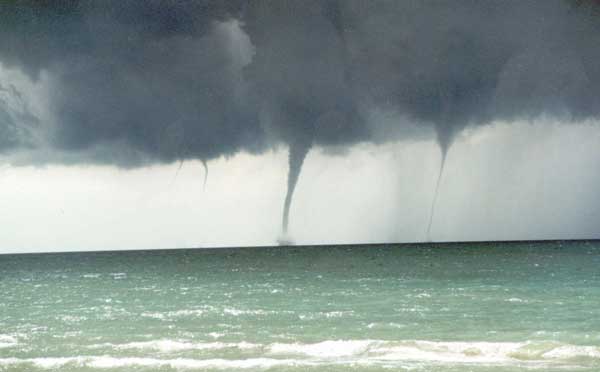

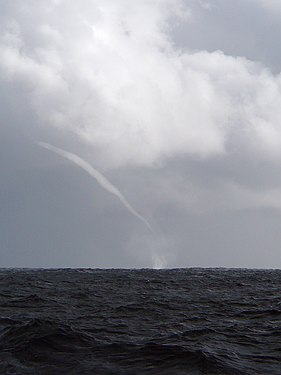
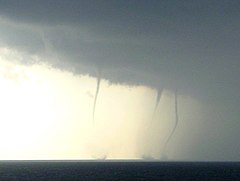




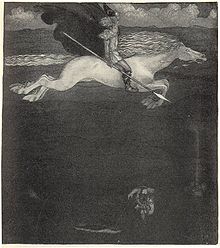

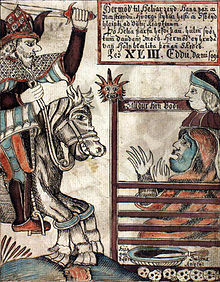
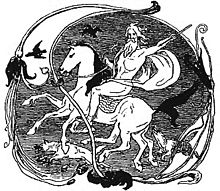
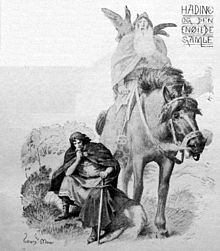


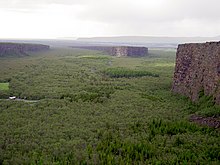
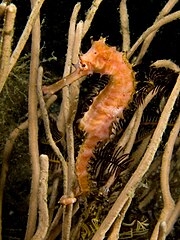

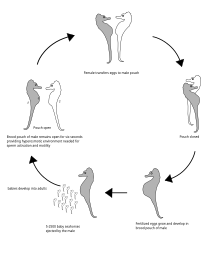




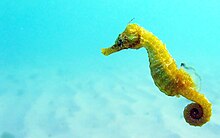


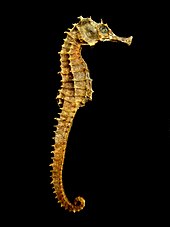


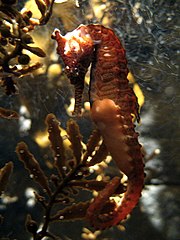











No comments:
Post a Comment